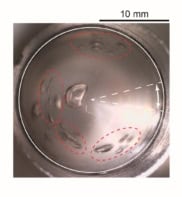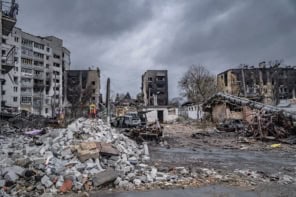The Chicxulub impact structure in Mexico is widely believed to be the site of the asteroid impact that allegedly killed the dinosaurs. As Sergio de Régules reports, scientists are now preparing to glean from it new insights in crater formation, materials science and mechanisms of mass extinction
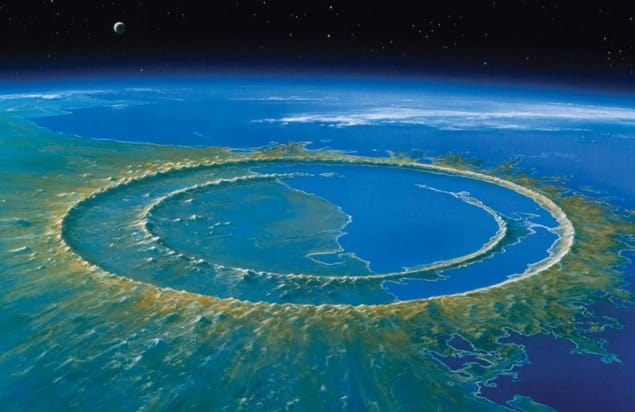
In 1978 Antonio Camargo and Glen Penfield, two geophysical engineers, conducted an aeromagnetic survey over the Gulf of Mexico. Their aim was to map the likelihood of finding oil for their employer – the Mexican state-owned oil company Petróleos Mexicanos (PEMEX). What they found, however, would have far larger implications.
To map the magnetic field, a plane equipped with sensitive magnetometers flew a series of 400 km traverses over Mexico’s territorial waters. The scientists were looking for minute local variations in the Earth’s magnetic field that would provide clues about the rock formations buried beneath a thick layer of sediments. The data revealed a ghostly arc at a depth of 600–1000 m that when matched up with a 1950s PEMEX gravity map of the neighbouring Yucatán peninsula formed a huge 200 km-diameter circular feature, spanning the land and the seabed. Camargo and Penfield proposed that they had found either an ancient volcanic caldera or an impact crater, centred on the town of Chicxulub Puerto (pronounced “Cheek-shoo-LOOB”).
The two researchers reported their findings to little ceremony at a meeting of the Society of Exploration Geophysicists in 1981. At around the same time, another conference was held to discuss the bombshell of a hypothesis dropped the previous year: the asteroid-impact theory of how the dinosaurs became extinct. The idea came from the recent physics Nobel laureate Luis Alvarez and his earth-scientist son Walter Alvarez. The Alvarezes and their co-workers claimed to have good evidence that the mass extinction that wiped out the dinosaurs, along with 75% of all species, at the end of the Cretaceous – some 65 million years ago – was caused by the impact of a 10 km-diameter asteroid. Initially, the impact hypothesis raised hackles among geoscientists and palaeontologists, still mired in “gradualism” – the overarching idea that geological change is always slow and gradual, never sudden and catastrophic. The fact that Luis was a physicist probably did not help endear him or his theory to the mainstream earth-science community, which considered him an outsider or even a trespasser. Over the following years, most objections would give way, but one pesky question recurrently plagued the theory: where is the crater?
Today, most scientists agree that the Chicxulub structure is the site of an end-Cretaceous impact, and that this impact killed the dinosaurs
In 1991, nearly a decade later, Camargo and Penfield co-authored a paper with Canadian geophysicist Alan Hildebrand and others, in which they finally brought these two stories together. Today, most scientists agree that the Chicxulub structure is the site of an end-Cretaceous impact, and that this impact killed the dinosaurs.
Peak priorities
Like many breakthroughs in science, consensus does not come instantly. But research has continued to suggest that this is an impact crater, which caused a global environmental catastrophe 65 million years ago. A leader in this field is Jaime Urrutia Fucugauchi, a researcher at the Institute of Geophysics of the National Autonomous University of Mexico (UNAM). Urrutia’s office, in the research district of UNAM’s huge Mexico City campus, sits atop a small warehouse containing shelf upon shelf of flat corrugated plastic boxes. These boxes hold hundreds of metres of cylindrical core samples extracted from boreholes in Yucatán. The samples were collected in the 1990s and early 2000s in the course of drilling projects coordinated by UNAM and co-sponsored by the International Continental Scientific Drilling Program. UNAM and PEMEX are the sole possessors of rocks from the crater. “We have distributed more than 15,000 samples around the world,” says Urrutia. Those samples have helped establish the claim that the Chicxulub crater does indeed match the Alvarez impact theory.
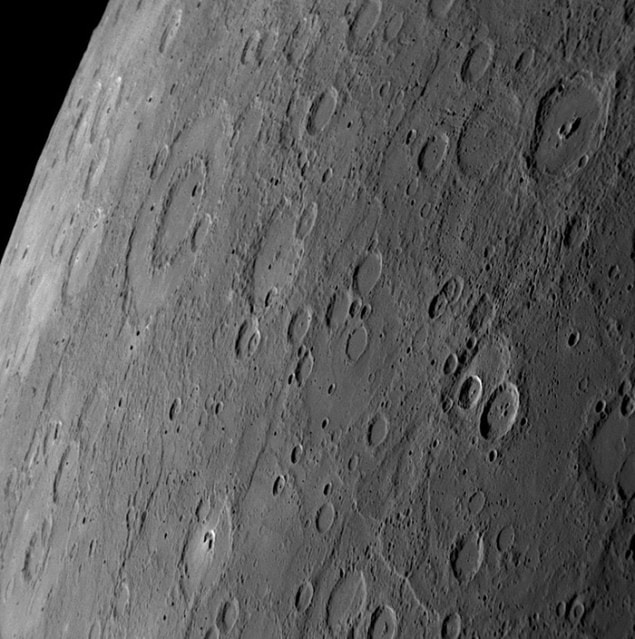
Today, research on Chicxulub ranges far beyond the demise of the dinosaurs. In March this year, scientists met in the Yucatán city of Mérida, located near the heart of the crater, to fine-tune the strategy for a new offshore drilling programme set to start in 2016, which will produce the first offshore samples from the structure. High on the scientists’ agenda is obtaining rock samples from a region known as the peak ring – a roughly circular chain of hills that forms around the centre of large impact basins. Although the peak ring is also present in the land sector of the crater, says Urrutia, we have a better picture of its offshore part, which has been thoroughly imaged by sending sound waves into the Earth’s crust and studying how they bounce back on different rock layers (seismic reflection and refraction surveying), a technique that yields better results at sea than on land. This is why the most promising locations for sampling the peak ring are offshore.
Craters with peak rings are common on the Moon, Mars, Mercury and other rocky bodies in the solar system. Chicxulub is the only crater on Earth known to have one, as the world’s two largest impact craters – in Canada and South Africa – have been significantly eroded thanks to their older age. The upcoming studies of Chicxulub will help scientists to understand how peak rings form and how the final crater structure depends on impact parameters and the conditions of the impacted planet (such as gravity, density and rock properties). As a result, it could enable geoscientists to infer subsurface characteristics of other planetary bodies – especially the Moon – by simply studying their craters.
There are two competing models of peak-ring formation, Urrutia explains. Both consider the rocks to behave temporarily like a liquid (smaller craters, by contrast, form in the “brittle regime” and are better understood). In one model, the middle of the impact splashes upwards like the central peak you can see fleetingly when a raindrop hits water. This central uplift then collapses, spreading outwards like a ripple in a pond and solidifying to form the ring. In the second model, the ring is created when the newly formed crater rim collapses and the material moves inwards. Samples from Chicxulub’s peak ring will help scientists determine which is the best model. “We have to be very sure of where to drill,” says Urrutia. “You can’t go, ‘Oops! Wrong location, we have to drill again’, when each drilling run costs several million dollars.”
The project will also help scientists to understand how materials behave at incredibly high deformation speeds – how rocks fracture, as well as the transition from brittle- to fluid-like behaviour when the deformation happens within a very short time. “Craters form in a flash,” says Urrutia. “When mountains are created, the deformation takes millions of years, but in an impact, the central uplift can rise higher than the Himalayas in two minutes.”
Apocalypse then
Even if research at Chicxulub has diversified over the past 20 years, impact scientists are still interested in what, exactly, caused the environmental changes that triggered the mass extinction. When the asteroid slammed into the Earth, it released an energy equivalent to that of 510 million Hiroshima bombs, which is one for every square kilometre of the planet’s surface. That is according to a proposal from 19 institutions across eight countries presented in 2008 to the International Ocean Discovery Program (IODP), which is footing the roughly Mex$162m (US$10m) drilling bill. The 21 proponents, led by Joanna Morgan of Imperial College London and Sean Gulick of the University of Texas at Austin, believe that the energy transfer from the impact to the environment remains poorly understood.
In their original paper, the Alvarez team blamed this biological catastrophe on the huge cloud of debris that shrouded the planet in darkness and cold for years after the impact. Later, other scientists proposed further effects, such as the release of greenhouse gases and acid rain. One theory even suggests that minutes after the asteroid hit, rocks ejected into suborbital flight re-entered the atmosphere in a global shower of exploding meteoroids that raised temperatures to a few hundred degrees for a short period, possibly igniting wildfires.
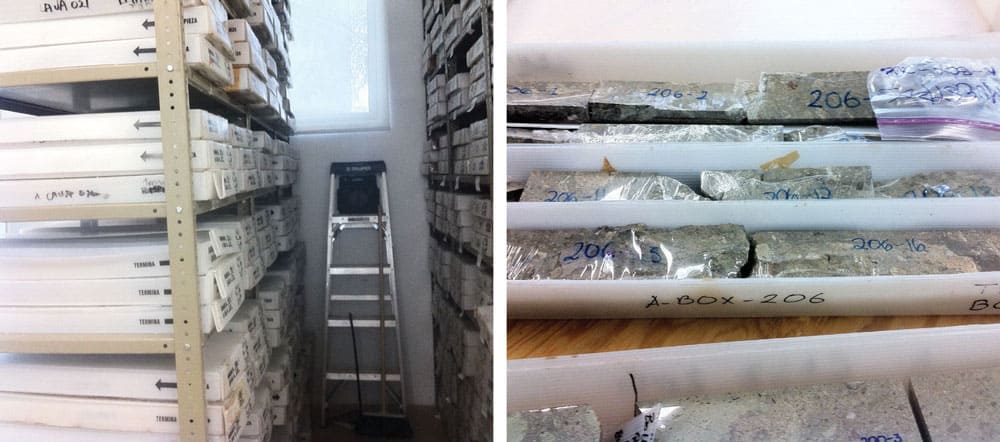
Today, despite 30 years of debate, there is no certainty about the relative importance of these events in causing the extinction, and recent simulations and experiments suggest that the wildfires probably never even happened, though the existence of an initial heat pulse is not in question. Now, computers have the power to model the aftermath of the impact and characterize how dust and gas affected the climate. Revisiting the “crater of doom”, as Walter Alvarez called the Chicxulub basin in a 1997 book, will help adjust the input parameters for our scientific model of the apocalypse. “The plan is to do stable isotopes, geochemistry, petrography and mineralogy,” says Urrutia.
Stable-isotope analysis, in particular, may help the team deduce post-impact environmental conditions, such as the temperature of the water encountered by the first organisms to colonize the crater after the catastrophe. The key to this analysis are the fossilized remains of tiny marine organisms called foraminifera, which incorporate oxygen from the water to form their calcium-carbonate shells. The ratio in the shells of two stable isotopes of oxygen, 16O and 18O, is a function of water temperature at the time of incorporation, and remains unchanged after the foraminifera die and fall to the bottom of the sea as sediment. Stable isotopes can also tell scientists how long it took for marine life to rebound.
In the 2008 proposal to the IODP, the researchers said that immediately after the impact, the peak ring was submerged and located adjacent to a thick pool of hot melt rocks. This source of heat lasted a million years, a fraction of the 65 million years since the asteroid hit, and “may have provided a niche for exotic life forms,” says the proposal, just as hydrothermal vents do in present-day oceans. Drilling samples of the first sediments that accumulated after the catastrophe is another scientific objective for the new programme. The results may shed light on how the life-forms of the very distant past coped with near-extinction. Three billion years ago, during the Precambrian geological period, impact rates were significantly higher than they are today, or at the time of the dinosaurs, yet species still managed to bounce back from those events. The re-population of Chicxulub is therefore a proxy for those turbulent times.
The oil connection
Research at the crater has come full circle in a way. Chicxulub was discovered in the course of oil exploration in the 1950s and 1970s. In 2000 José M Grajales Nishimura, of the Instituto Mexicano del Petróleo, and others including Walter Alvarez, found material in the Cantarell oil field in the Gulf of Mexico that originates from the Chicxulub crater, 300 km northeast of the crater itself. Cantarell was, at the time, the second most productive oil field in the world. The discovery established a link between the impact and the oil-bearing strata at Cantarell, made of a type of mineral called “breccia” – chunks of rock cemented together by a finer-grained material. (Imagine a Toblerone bar with its chunks of nougat embedded within the chocolate.)
The Yucatán peninsula is the land section of a much larger limestone platform made of the tiny carcasses of marine organisms that began to accumulate around 140 million years ago. This is why the land is so low and flat, and why the much-loved sands at Cancun are so beautifully white. The Cantarell breccias were formed when the margins of the platform collapsed because of the widespread violent shaking that was triggered by the impact. Much later, hydrocarbons migrated from several kilometres beneath the Earth’s surface into the breccias, which act as oil reservoirs.
Study of the impact is useful for oil exploration in the region, because it suggests not just where to look for oil, but also where not to look
Today, production at Cantarell is petering out and PEMEX is developing the offshore Ku-Maloob-Zaap field, located to the north-west of Cantarell, although production there is also declining. Study of the impact is useful for oil exploration in the region, because it suggests not just where to look for oil, but also where not to look. It is no use looking in the crater itself (and to a depth of 40 km, which is how far into the Earth the impact extends) because any oil previously formed would have been vaporized by the impact.
There is a final, intriguing, direction Chicxulub science might go one day. During the impact, tonnes of ejected material must have acquired escape velocity – a one-way ticket into space. Some of this material may have eventually landed on our nearest cosmic neighbour. So, muses Urrutia, “There must be bits of Yucatán on the Moon!” Clearly, however, spotting this debris and then linking it with the Chicxulub impact will be a task for geologists of the future. For the time being, Chicxulub science is keeping its feet on the ground – or underneath it, where there is a lot more of Yucatán to keep the scientists busy.

